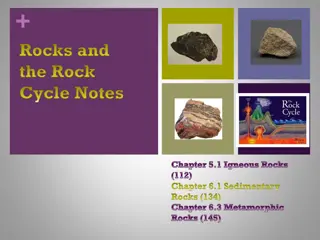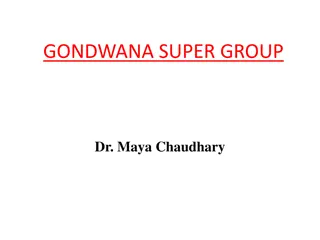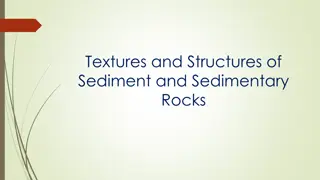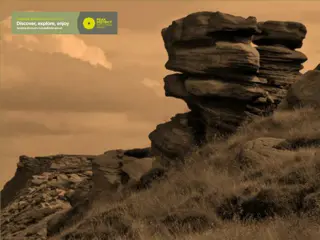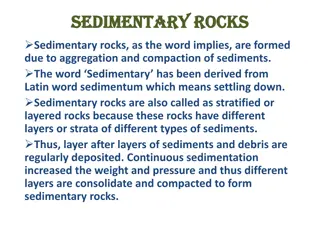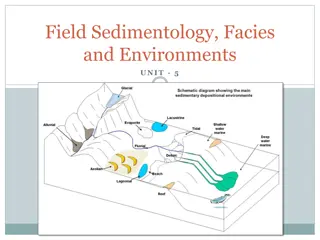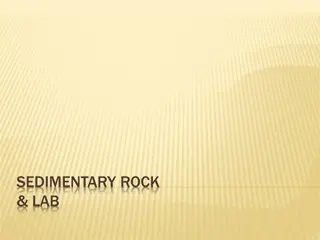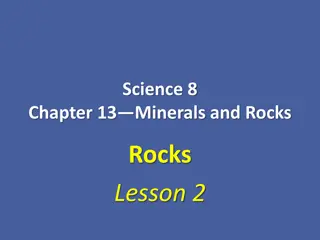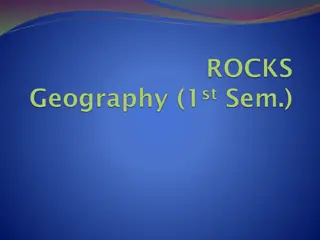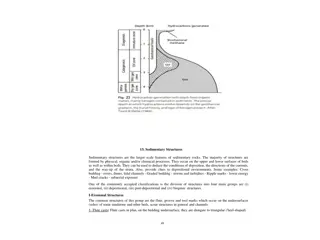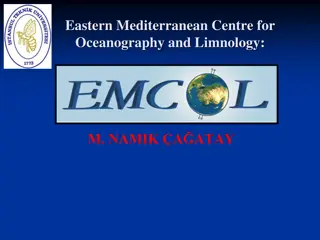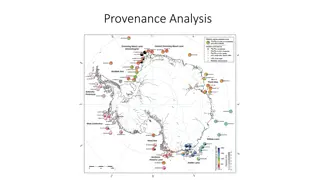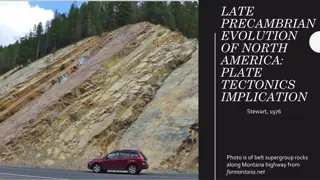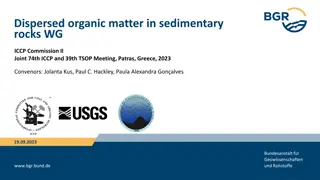Understanding Sedimentology: An Overview of Sedimentary Processes and Rocks
Sedimentology is the study of modern sediments like sand, mud, and clay, along with the processes involved in their deposition. Sedimentologists use this knowledge to interpret Earth's geologic history through sedimentary rocks and structures. Sediment plays a crucial role in enriching soil with nutrients, influencing biodiversity, and supporting agriculture. By understanding sediment movement and deposition, geologists reconstruct past environments and geological features.
Download Presentation

Please find below an Image/Link to download the presentation.
The content on the website is provided AS IS for your information and personal use only. It may not be sold, licensed, or shared on other websites without obtaining consent from the author. Download presentation by click this link. If you encounter any issues during the download, it is possible that the publisher has removed the file from their server.
E N D
Presentation Transcript
GEY 314 SEDIMENTOLOGY Tuesday 7 9 pm
COURSE OUTLINE: Origin of Sediments Sedimentary Rocks Sedimentary Processes: Physical Chemical Biological Depositional Environments Statistical study of Texture Structure and Composition of Sedimentary rocks Description of Sedimentary rocks Sedimentary Structures Analysis of Paleo-current data.
SEDIMENTOLOGY Sedimentology encompasses the study of modern sediments such as sand, mud (silt), and clay, and the processes that result in their deposition. Sedimentologists apply the understanding of modern processes to interpret geologic history through rocks and sedimentary structures. Sedimentary rocks cover most of the Earth s surface, keep record of the Earth's history, and harbour fossil record. Sedimentology is closely linked to stratigraphy, the study of the physical and temporal relationships between rock layers or strata. The premise that the processes affecting the earth today are the same as in the past is the basis for determining how sedimentary features in the rock record were formed. By comparing similar features today to features in the rock record for example, by comparing modern sand dunes to dunes preserved in ancient aeolian sandstones geologists reconstruct past environments. observations of sedimentary
What is Sediment? Sediment is a solid material that is moved and deposited in a new location. Sediment can consist of rocks and minerals, as well as the remains of plants and animals. It can be as small as a grain of sand or as large as a boulder. Sediment moves from one place to another through the process of erosion. Erosion is the removal and transportation of rock or soil. Erosion can move sediment through water, ice, or wind. Water can wash sediment, such as gravel or pebbles, down from a creek, into a river, and eventually to that river's delta. Deltas, river banks, and the bottom of waterfalls are common areas where sediment accumulates. Ice can freeze sediment and then deposit it elsewhere as the ice carves its way through the landscape or melts. Sediment created and deposited by glaciers is called moraine.
What is Sediment? (Cont) Wind can move dirt across a plain in dust storms or sandstorms. Sand dunes are made of rocky sediment worn down by wind and collision with other sand particles. Sediment is important because it often enriches the soil with nutrients. Areas rich in sediments are often also rich in biodiversity. Sedimentary soil is usually better for farming. Deltas and river banks, where much sediment is deposited, are often the most fertile agricultural areas in a region. For thousands of years, the Nile River flooded yearly and brought with it 4 million metric tons (4.4 million short tons) of nutrient-rich sediment. The banks of the Nile are still Egypt's richest agricultural land.
Sediment is defined by the size of the particles that make up the sediment. Sedimentary rocks are formed in three ways from these different sized sediments.
Sedimentary rocks Sedimentary rocks are types of rock that are formed by the accumulation or deposition of small particles and subsequent cementation of mineral or organic particles on the floor of oceans or other bodies of water at the Earth's surface. Sedimentation is the collective name for processes that cause these particles to settle in place. Before being deposited, the geological detritus was formed by weathering and erosion from the source area, and then transported to the place of deposition by water, wind, ice, mass movement or glaciers, which are called agents of denudation. Biological detritus was formed by bodies and parts (mainly shells) of dead aquatic organisms, as well as their fecal mass, suspended in water and slowly piling up on the floor of water bodies (marine snow). Sedimentation may also occur as dissolved minerals precipitate from water solution. The sedimentary rock cover of the continents of the Earth's crust is extensive (73% of the Earth's current land surface), but the total contribution of sedimentary rocks is estimated to be only 8% of the total volume of the crust.
Sedimentary rocks (Cont) Sedimentary rocks are only a thin veneer over a crust consisting mainly of igneous and metamorphic rocks. Sedimentary rocks are deposited in layers as strata, forming a structure called bedding. The study of sedimentary rocks and rock strata provides information about the subsurface that is useful for civil engineering, for example in the construction of roads, houses, tunnels, canals or other structures. Sedimentary rocks are also important sources of natural resources like coal, fossil fuels, drinking water or ores. The study of the sequence of sedimentary rock strata is the main source for an understanding of the Earth's history, paleoclimatology and the history of life. The scientific discipline that studies the properties and origin of sedimentary rocks is called sedimentology. Sedimentology is part of both geology and physical geography and overlaps partly with other disciplines in the Earth sciences, such as pedology (soil science), geomorphology, geochemistry and structural geology. Sedimentary rocks have also been found on Mars. including, palaeogeography,
Sedimentary Rocks Sedimentary rocks are those rocks which form at or near the earth's surface primarily through: Deposition of weathered silicate material by water, wind, or ice (detrital, clastic, terrigenous) Direct inorganic chemical precipitation from water Precipitation by organic processes 9 clasbased
Evolution of Sedimentary Rocks
A sedimentary rock is a layered rock that is formed from the COMPACTION, CEMENTATION, and the RE-CRYSTALLISATION of sediments. The photos above show layers of sedimentary rocks that were deposited in flat horizontal layers. These layers were then uplifted and bent by mountain building.
COMPACTION is the squeezing together of layers of sediment due to the great weight of overlying layers of rock. This squeezing of the layer results in reduction in thickness of the original layer. When the layers are reduced in thickness, the pore spaces around the sediments are also reduced, which leads to a tighter packing of the layers. CEMENTATION is the changing of sediment into rock by filling spaces around the sediments with chemical precipitates of minerals. Binding the sediments, and forming solid rock. Calcite and silica are common minerals that cement the sediments together. RE-CRYSTALLISATION is the formation of new mineral grains that are larger than the original grains. As the sediments re-crystallise they arrange themselves in a series of interlocking crystals that connect the other grains together into a solid rock.
Sedimentary rocks form a thin layer of rock over 75 per cent of the Earth's surface. They are the site of very important resources such as ground water, coal, oil, and soil. Shale, sandstone, and limestone are the most common types of sedimentary rocks. They are formed by the most common mineral that is found on or near the surface of the Earth. The mineral that forms these sedimentary rocks is feldspar. Running water, such as the mountain stream above, sorts and transports more sediment than any other agent of deposition.
STRATA & FOSSILS The rock layers are called STRATA or BEDS and can be seen on eroded cliff faces, river valleys, and canyons, where earthquakes have uplifted the land. These strata often contain FOSSILS formed from the hard skeletons or shells of creatures that lived during that time. If the sediments are mainly plant material, the result is PEAT or COAL.
SEDIMENTARY ROCKS There are two major groupings of sedimentary rocks: Clastic sedimentary rocks e.g. conglomerate, shale, sandstone, siltstone, mudstone, and greywacke. Non-clastic sedimentary rocks e.g. limestone, chert, shale.
CLASTIC SEDIMENTARY ROCK The fragments of pre-existing rocks or minerals that make up a sedimentary rock are called CLASTS. Sedimentary rocks made up of clasts are called CLASTIC (clastic indicates that particles have been broken and transported). These particles and grains become solid rock by the processes of compaction or cementation of sediments. Clastic sedimentary rocks are primarily classified on the basis of sizes of their clasts.
NON-CLASTIC SEDIMENTARY ROCK NON-CLASTIC sedimentary rocks form from the precipitation of minerals from ocean water or from the breakdown of the shells and bones of sea creatures. Precipitation is the separation of a solid from a solution. Sea animals such as coral produce calcium carbonate solutions that harden to form rock. As the chemicals, that comes from the mineral or biological precipitation, mix with sediments on the floor of the ocean or lake they crystallize and grow in the spaces around the sediment. When these crystals grow large enough to fill the spaces they harden and form a solid rock.
ORGANIC SEDIMENTARY ROCK Organic sedimentary rocks form from the build up and decay of plant and animal material. This usually forms in swamp regions in which there is an abundant supply of growing vegetation and low amounts of oxygen. The vegetation builds so quickly that new layers of vegetation bury the dead and decaying material very quickly. The bacteria that decay the vegetation need oxygen to survive. Because these decaying layers are buried so fast the bacteria use up the oxygen that is available and can not finish the decomposition of the vegetation. The overlying layers become so heavy that they squeeze out the water and other compounds that aid in decay.
COMMON EXAMPLES OF SEDIMENTARY ROCKS Common examples of sedimentary rocks include: Coal Shale Sandstone Mudstone Limestone Conglomerate Etc.
COAL Compressed vegetation forms COAL. The longer and deeper that coal is buried makes it of higher quality. Peat is the first stage of coal formation. Lignite is the next grade of coal followed by bituminous and the highest grade, anthracite. Anthracite is actually a metamorphic rock. It forms during mountain building when compaction and friction are extremely high. This form of coal burns very hot and almost smokeless. It is used in the production of high grade steel.
SHALE Shale is one of the most common sedimentary rocks. It is composed of silt or clay that has been compacted or squeezed together to form a solid rock. Shale is usually found in thin layers. The silt or clay that form shale is made of very small pieces of weathered rock. The pieces are 1/16 to 1/256 of a millimetre in diameter. The colour of a sample of shale is that of the clay or silt that it was formed from.
SANDSTONE & MUDSTONE Sandstone & mudstone are clastic sedimentary rocks that form from the cementing together of sand sized grains & silt sized grains respectively forming a solid rock. Quartz is the most abundant mineral that forms sandstone. Calcium carbonate, silica, or iron has been added to the water that is in contact with the sand grains. These minerals grow crystals in the spaces around the sand grains. As the crystals fill the gaps the individual sand grains are now transformed into a solid rock. Sandstone-mudstone on the Wairarapa coastline
LIMESTONE Limestone is the most abundant of the non-clastic sedimentary rocks. Limestone is produced from the mineral calcite (calcium carbonate) and sediment. The main source of limestone is the limy ooze formed in the ocean. The calcium carbonate can be precipitated from ocean water or it can be formed from sea creatures that secrete lime such as algae and coral. Chalk is another type of limestone that is made up of very small single- celled organisms. Chalk is usually white or grey in colour. Limestone at Te KauKau Point, Wairarapa
LIMESTONE CAVES Limestone caves are an interesting geological feature. They form because the limestone deposits located under the ground are chemically dissolved by moving ground water. The ground water contains minerals that make the water slightly acidic. When an acid comes into contact with a rock that is composed of calcium carbonate a chemical reaction takes place. The acid dissolves the limestone. The calcium carbonate then goes into the ground water which moves down farther into the cave. The water will find its way into small crack and crevasses. The dripping water will create formations called stalactites and stalagmites. The photo shows these in Waitomo Caves.
CONGLOMERATE Conglomerate is a clastic sedimentary rock that forms from the cementing of rounded cobble and pebble sized rock fragments. Conglomerate is formed by river movement or ocean wave action which rounds the rock edges. The cementing agents that fill the spaces to form the solid rock conglomerate are silica, calcite, or iron oxides. Conglomerate, South Wairarapa
OTHER SEDIMENTARY ROCKS Halite rock salt Chert Greywacke Breccia



